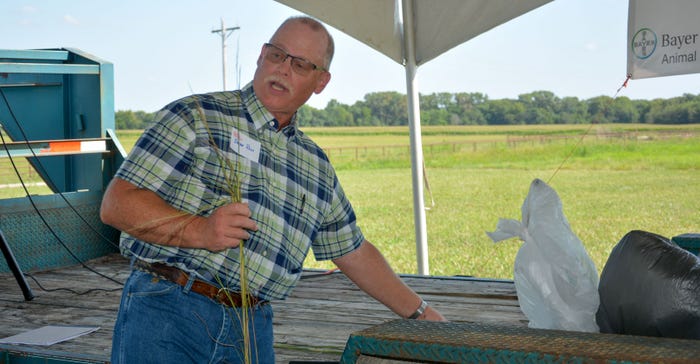
The Kansas Flint Hills pastures are green, serene and incredibly beautiful as the autumn of 2019 rolls around. A summer of good rains has restored the levels of pasture ponds and left the grasslands emerald green.
Don’t let the serenity fool you. There’s an invasion under way that threatens the very life of the unique ecosystem that comprises the last, tiny percentage of the original prairie grasses that once covered vast stretches of the American Midwest and Great Plains.
Brian Rees, Lyon County Agriculture Extension agent, talked about that invasion during a Kansas Livestock Association field day on Aug. 15 on Moyer Farms near Emporia. The invaders are related grass species know as old world bluestems: Caucasian bluestem and yellow bluestem.
Like many of the species that now threaten to overwhelm native vegetation, these grasses were imported to the U.S. as forage grass and erosion control. They are able to withstand close grazing and became popular in neighboring states.
They are, however, less palatable to cattle than the native warm season grasses of the prairie, and they have been found to be highly invasive in Missouri, Kansas, Oklahoma and across the southern U.S. They spread by both root and seed, and the length of seed viability in the seed bank is unknown.
Because both cattle and wildlife prefer the native grasses, the old world bluestems have a competitive advantage. They can also inhibit the growth of native species in the soil immediately surrounding them and make the ground more erodible, Rees said.
He said that yellow bluestem has been found on hillsides with only about 2 inches of soil covering the rock and was still able to achieve robust growth.
They are so closely related that controlling them without damaging native grasses is virtually impossible. They form a deep and extensive root system and cannot be dug, tilled or pulled. They are fire-adapted and thrive with annual burns. Biological agents that damage them also damage native grasses and there are no herbicides available that will control them without also killing native grasses.
Glyphosate will control old world bluestems but will also kill any native or desirable species. Imazapyre is less efficient at killing old world bluestems but is less damaging to native grasses.
“This makes them in some ways a worse threat than sericea lespedeza,” he said. “Sericea is a broadleaf, and that means you can control it with chemicals that don’t damage the native grasses.”
Rees said other efforts to control the invasive grasses are being done by trial and error. He said future plans include trying to see if summer fire helps inhibit the growth of the invasive species. Summer burning has been shown to be effective against sericea lespedeza because it knocks the plant back before it can produce seed.
He said control of the invasive species starts with quickly identifying the grasses as the invaders they are.
“It’s easy to confuse them because they do look so much like our native grasses,” he said. “We are encouraging ranchers to keep pictures handy for comparison if they spot a grass they don’t recognize.”
Rees said K-State is encouraging the Kansas Department of Transportation to spray the weeds found in ditches, and in counties where infestations are known to exist crews have stopped mowing areas where it is growing to avoid spreading it.
“There has been some conversation with the State Board of Agriculture about listing old world bluestems as noxious weeds, but there have been some concerns about creating problems with that,” Rees said. “Once you list it as a noxious weed, then control is mandatory and that could put a very expensive burden on property owners. Spraying is expensive. And if you have to use glyphosate to knock it back, you also have the expense of re-seeding your native grasses.”
About the Author(s)
You May Also Like






